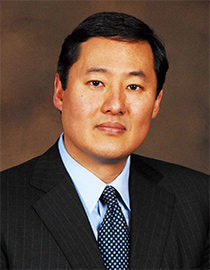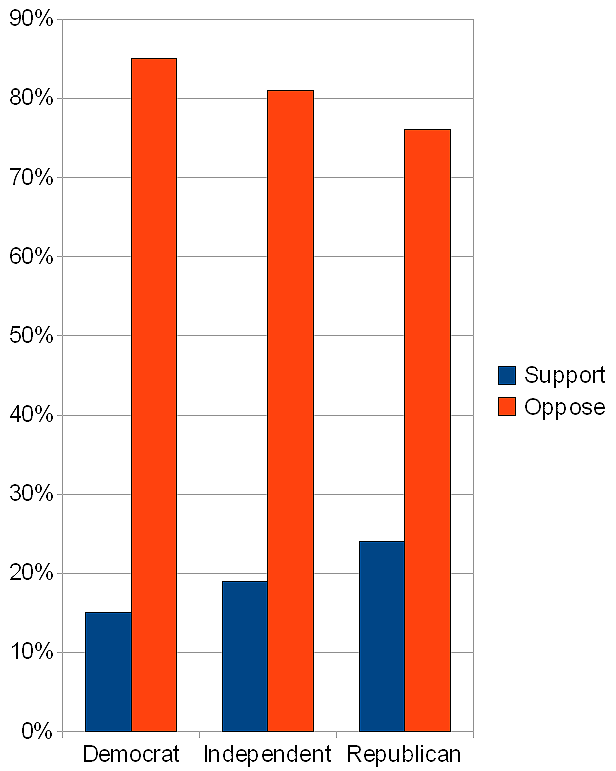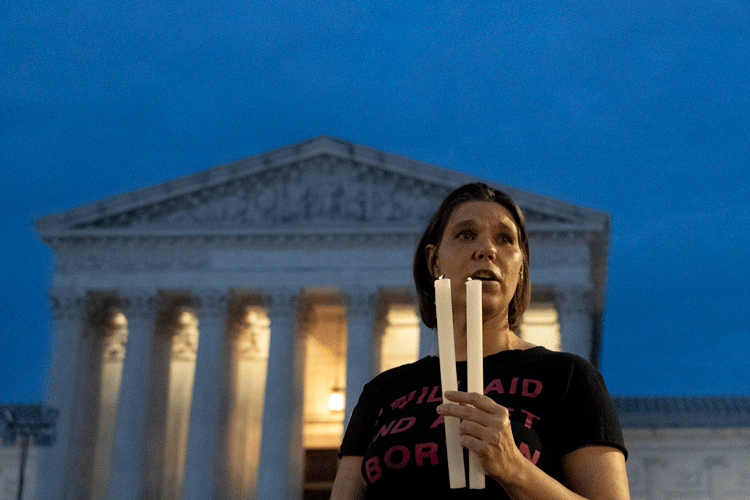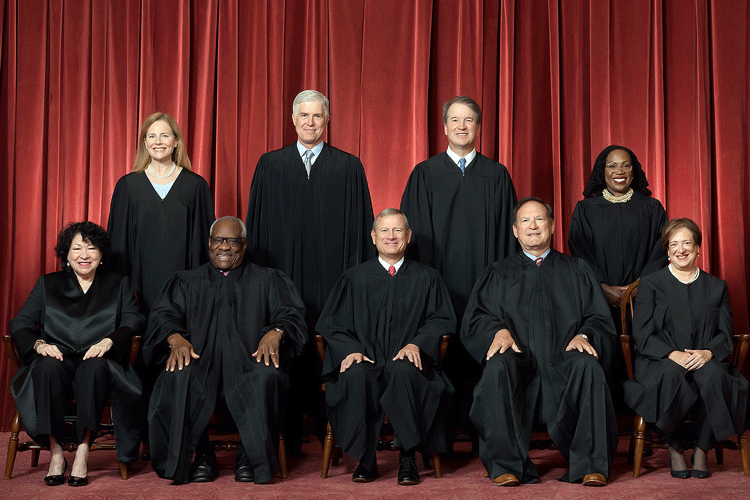Voting, race and religion: Is the U.S. Supreme Court a threat to democracy?
Berkeley scholars say the court may be helping to assemble a legal framework in which a shrinking base of white conservatives can rule the country long-term — even as a minority
March 9, 2023

Legal analysts at UC Berkeley and nationwide worry that recent actions by the increasingly conservative U.S. Supreme Court are jeopardizing core standards of democracy. (Photo illustration by Neil Freese, UC Berkeley)
The case is reminiscent of civil rights battles in a long-ago era: Alabama’s Republican lawmakers, drawing seven new congressional districts in 2021, split the state’s broad “Black belt” among four districts. Though Black citizens account for 27% of the state’s population, they would be a minority in every district but one.

Berkeley News is examining threats to U.S. democracy in a series that draws on the expertise of campus scholars.
Voting rights advocates sued the state, arguing that the districts illegally diluted Black political power. Lower courts agreed, and ordered the legislators to draw more equitable maps before the 2022 midterm elections.
But when the U.S. Supreme Court took the case, the conservative majority allowed the maps to stand, pending a full review this spring. Last November, white Republican men won six of Alabama’s gerrymandered districts, leaving the last seat to a Black woman.
For many legal analysts nationwide, including some at the UC Berkeley School of Law, the high court’s intervention was the latest in a series of recent rulings that are jeopardizing core standards of democracy. In the span of less than 15 years, they say, an increasingly conservative court has eroded limits on campaign donations and hollowed out the monumental Voting Rights Act of 1965. Last year, the court’s six conservative justices seemed to embrace conservative Christian doctrine in decisions that limit abortion rights and advance public school prayer.

Erwin Chemerinsky (UC Berkeley School of Law photo)
“At a time when our country is so politically polarized, the Supreme Court is a risk factor for American democracy,” said Berkeley Law Dean Erwin Chemerinsky, one of the nation’s preeminent constitutional scholars. “What’s it going to mean to have a Supreme Court that’s come down so clearly on one side of that divide and so far to the right on that side of the divide?”
It could mean law, at every level, that is more hostile to people who have long suffered from political and social exclusion, said Berkeley Law Professor Russell K. Robinson, faculty director of the Center on Race, Sexuality and Culture.
“Our country is becoming more diverse,” Robinson said. “We’re seeing more and more the browning of America. More young people identify as non-heterosexual, non-cisgender. … But it feels like this is a backward-looking court. It’s not embracing demographic change — in some ways, it’s trying to lock in the traditional ways of understanding power and who holds power in America.”

Russell K. Robinson (UC Berkeley School of Law photo)
Indeed, conservatives throughout much of the U.S. have moved to recast election processes and to constrict rights in ways that appear designed to limit the political power held by people of color, women and LGBTQIA+ communities. Many of the most high-profile cases before the high court in recent years involve fiercely contested issues of race, gender and religion.
Doubts about the court’s commitment to democracy are underscored by the brass-knuckle politics that conservatives have used to nominate and affirm allied Supreme Court justices. The doubts are further inflamed by ethical issues, as court conservatives in some instances seem to have shed impartiality and to be working closely with religious and political allies.
In a new series of decisions due before the end of June, the court is expected to continue its focus on these contentious issues. At stake, Berkeley scholars say, is a critical question for American democracy: With the nation dangerously divided over demographic and cultural change, is the court helping to assemble a legal structure in which a shrinking base of white conservatives can rule the country long-term, even as a minority?
A legal war for power — and for the meaning of democracy
In a practical sense, the intermingled legal, political and symbolic conflicts that come before the Supreme Court often are conflicts about the values of democracy, how democratic processes should work, and even the meaning of the word.

Brass-knuckle political tactics employed by U.S. Sen. Mitch McConnell, the Republican Senate leader, helped President Donald Trump to appoint three solidly conservative justices to the Supreme Court in four years. (Photo by Gage Skidmore via Flickr)
In the view of Berkeley Law Professor John Yoo, critics often misunderstand the court’s role. “The Constitution’s design and the Supreme Court’s job is not to advance democracy,” he said. “It’s to maintain the guardrails that the Constitution imposes on democracy.”

John Yoo (UC Berkeley School of Law photo)
The nation’s founders worried that a majority of voters, with passions inflamed by some issue or cause, might trample the rights of the minority, he said. To counteract that risk, they decentralized power to three branches of federal government and to the states. And they gave the Supreme Court power to review actions by Congress and the Executive Branch — in effect, a way to moderate extreme actions driven by a runaway majority.
The current court is simply performing the role advocated by the founders, said Yoo, who held a high-level Justice Department post during the administration of President George W. Bush.
Others, however, suggest that the Supreme Court has a long history of supporting a majority that’s trampling on minority rights. The most stark example: racial justice.

Khiara M. Bridges (UC Berkeley School of Law photo)
Soon after the Civil War, the U.S. ratified constitutional amendments that prohibited slavery and racial discrimination, and gave Black men the right to vote. But in 1896, the court sanctioned “separate but equal” treatment for Black and white people. That created a framework for Jim Crow laws that allowed the white majority to repress Black people with impunity — and often to block them even from voting.
“If a democracy is characterized as the people being able to vote for lawmakers who will represent their interests, this country was not a democracy until the passage of the Voting Rights Act of 1965,” said Berkeley Law Professor Khiara M. Bridges.
Campaigns, elections and voting rights — a sustained erosion

Charlotte Hill (UC Berkeley photo)
Since 2010, the Supreme Court has delivered a succession of rulings focused on changing the rules of elections. The decisions have given potent new advantages to wealthy and corporate donors, and to governments that seek to make voting more difficult. Two more cases with potentially far-reaching consequences may be decided by the end of June.
“The Supreme Court is deciding election cases in ways that enshrine minority rule and keep some voters, particularly Black voters, from having an equal political voice,” said Charlotte Hill, director of the new Democracy Policy Initiative at the Goldman School of Public Policy. “That then could create a bias in election outcomes and create the potential for more right-leaning court appointments down the road.”
Generally, the cases fall into three areas:

Henry Brady, dean of the Goldman School of Public Policy
Election financing. The court in recent years has loosened a century of controls on political donations and campaign spending, said Berkeley political scientist Henry Brady, former dean of the Goldman School. That has a direct bearing on important policy — in climate change, for example, or reproductive rights or gun control.
The most momentous decision came in 2010, when the court’s conservative bloc concluded that the government could not limit independent spending on political campaigns. Campaign spending is a form of speech protected under the First Amendment, the court said — and corporations and advocacy groups have free speech rights, just like people.

In 2010, just after the U.S. Supreme Court’s landmark ruling in the Citizens United case, an ABC-Washington Post poll found voters across party lines overwhelmingly opposed the decision to relax laws on campaign donations. (Wikipedia)
Today, Brady said, billions of dollars in donations, often from anonymous donors to political action committees, have created an unprecedented power imbalance between special interests and average voters. While both Democrats and Republicans benefit from these donations, most of the individual mega-donors to super PACs are conservatives.
“The top 100 donors to super PACs basically give two-thirds or more of the total money spent on elections,” Brady said. “And so a very, very small group of people have given large sums of money to the super PACs. Those super PACs then run ads. There’s no transparency.”
“Some of these donations come directly from corporations,” he continued, “but corporations are not people. The one thing they want to do is maximize profits. They’re not trying to help other social aims. And the result is that we’ve empowered corporate sector institutions, and they now have tremendous powers to affect outcomes in policy debates.”
Voting rights. The Voting Rights Act of 1965 was a landmark in the mid-20th century campaign against institutionalized racial discrimination, especially the overt discrimination practiced in the Old South. The law gave the federal government broad authority to monitor state and local efforts to suppress voting on the basis of race — and to block those efforts, if needed.

Then-President Lyndon B. Johnson (left) met with the Rev. Martin Luther King (center) and other civil rights leaders after Johnson signed the Voting Rights Act of 1965. The law has been a monument of the civil rights era, but Berkeley scholars say that, nearly 60 years later, a conservative U.S. Supreme Court is eroding it. (Photo by Yoichi Okamoto, courtesy of the LBJ Presidential Library)
The Alabama gerrymandering case now awaiting a final decision is the Supreme Court’s latest opportunity to undercut the Voting Rights Act. The justices have already gutted a key section of the law: In 2013, they ruled that the government’s approach was invalid because it could not target states for review based on the states’ racial practices more than 50 years earlier.
Then, in 2019, the conservative bloc ruled in two cases that gerrymandering — partisan manipulation of voting districts to undercut the opposing party — is a political matter and not for the courts to regulate.
The decisions have provoked a surge of extreme gerrymandering and vote suppression legislation, Hill said. Most of it is in Republican-dominated states, often in the states that would have been targeted under the Voting Rights Act. That suppression has the greatest effect on people of color and those who are low income, students and elderly.
“We now have far-right political leaders who are pushing for voter ID laws, pushing for shorter voting windows, pushing to make it harder for people to vote easily from home, pushing for the closing of polling places,” Hill said. “We have policy after policy that really does not serve the public interest.”
The independent state legislature theory. Another gerrymandering case, this one from North Carolina, has arrived at the Supreme Court backed by a legal doctrine that some Berkeley scholars see as an extraordinary threat to U.S. democracy.

Emily Rong Zhang (UC Berkeley School of Law photo)
While North Carolina is split evenly between Democrats and Republicans, the Republicans dominate the state legislature there. They drew new congressional districts that essentially assured their party would win 11 of the state’s 14 seats in the U.S. House. After the North Carolina Supreme Court struck the map down as a partisan gerrymander and sought to implement a more neutral map, the Legislature sought to overturn its decision at the U.S. Supreme Court.
In defense of North Carolina’s action, right-wing legal advocates have proposed that under the U.S. Constitution, state legislatures have virtually unlimited power to administer elections, evaluate the results and declare winners — without oversight by elected executives or the courts.
It’s called the “independent state legislature theory.” Emily Rong Zhang, a Berkeley legal scholar specializing in voting and elections, said the doctrine, if adopted in its most aggressive form, could give state legislatures — backed by the U.S. Supreme Court — unchallenged power over federal elections. To many legal scholars — including some top conservative experts — the doctrine has no basis in constitutional history. But several Supreme Court justices have already signaled some support.
Chemerinsky has a foreboding view. Writing recently in the Los Angeles Times, he called the case “ominous” and added: “It is not hyperbole to say that the future of American democracy may turn on the court’s answer.”
In November, North Carolina’s voters elected a new Republican majority to the state Supreme Court, and that court may reverse the previous decision and allow the gerrymandered districts. That could, in effect, take the case off the U.S. Supreme Court’s docket.
But, Berkeley experts say, the independent state legislature issue is likely to return.
Democracy is more than elections and voting
Other cases that have come before the Supreme Court are not about elections or political processes at all — rather, they’re about who holds power and whether power is fairly distributed.

The controversial U.S. Supreme Court decision on abortion rights last year raised a key question: Was the court returning legal authority on abortion to the states, or imposing conservative Christian values on the rest of society? (Photo by Gemunu Amarasinghe/AP)
For example, the court is due to decide two critical cases on affirmative action in college admissions. They’re not directly about democracy, but they’re clearly about whether and how the nation will remedy communities of color for systemic economic and political exclusion that has spanned centuries.
Last year’s decision to rescind abortion rights was not about elections, either. But it took bodily autonomy from half the nation’s population — and abortion rights are favored by a wide majority of Americans.
While that decision was controversial, Yoo outlined the court’s reasoning: The decision allowed states where abortion is unpopular to make their own choice, and by giving power to the states, he said, the court advanced democracy.
Others, however, saw the decision as an aggressive intervention into the private sexual and medical lives of women, one that will allow the majorities in some conservative states to impose their religious values on everyone.
“People have always said that democracy, liberty and freedom are all one and the same,” said Bridges. “But I think compelling people to give birth to children they don’t want to have is completely inconsistent with liberty or freedom.”
And because low-income women and women of color will likely have less access to reproductive services, she said, “that is certainly inconsistent with ‘freedom and justice for all.’”
Is the court using law to impose sectarian Christian values?
A U.S. Supreme court case with similar contours is due for a decision in June — but this time, the conflict between religious values and democratic values is front and center.

Lorie Smith, a Christian and the owner of 303 Creative in Colorado, argues that she cannot be required to design wedding websites for same-sex couples. The U.S. Supreme Court is considering a complex interplay of religious and free speech issues, with a ruling expected by the end of June. (Photo by David Zalubowski/AP)
The case focuses on a Colorado law that says if a business offers services to the public, it must offer them to everyone. But a website designer argues that her Christian beliefs prohibit her from building a wedding site for same-sex couples. An artist, she argues, cannot be forced to create art that violates her beliefs.
In arguments last year, the conservative justices appeared sympathetic to the designer’s complaint. But some analysts say that if the court sides with her, it would open the door to a range of discrimination on religious and other grounds.
“Would this mean that artists have a blank check to discriminate?” asked Robinson. “To say, artistically, ‘I don’t want to serve an interracial couple, I don’t want to serve a Jewish couple’?
“Is a chef an artist, so that a chef can refuse to serve Black people because he doesn’t want to send a message that Black people are equal? … People have assumed that we have a right to go to places of public accommodation — to sit at a restaurant, and that the restaurant can’t say, ‘No black people allowed.’ We thought that was resolved in the 1960s, right?”
Democracy, justice and the Supreme Court’s credibility
The Supreme Court today faces a legitimacy crisis unmatched since the presidency of Franklin D. Roosevelt in the 1930s. The court is increasingly seen as a partisan political body — and many critics say it’s acting like one.

The nine current justices of the U.S. Supreme Court (front row, from left): Sonia Sotomayor, Clarence Thomas, Chief Justice John Roberts, Samuel Alito, and Elena Kagan. (Back row, from left): Amy Coney Barrett, Neil Gorsuch, Brett Kavanaugh and Ketanji Brown Jackson. (Photo by Fred Schilling, U.S. Supreme Court)
Donald Trump in 2016 did not win a majority of America’s votes, but backed by the hardball judicial politics of Sen. Mitch McConnell, the Republican Senate leader, he was able to place three new justices on the court in the space of four years. Each is solidly conservative, religious and young; the trio could shape the court for the next 30 years.
In the same span, some conservative justices reportedly prayed with religious activists who had cases before the court. And Justice Clarence Thomas has declined to recuse himself from cases involving the insurrection of Jan. 6, 2021, even though his wife, Virginia Thomas, pressed top government officials to overturn the election results.
Hill, Robinson and other Berkeley scholars suggest that a segment of white Christians who used to comprise the American majority are now going to extremes to preserve power in a changing nation — and eroding the court and other democratic institutions in the process.
“You see these ruthless politics where balance and rules and comity and fairness are out the window,” Robinson said. “They seem to have just one concern: How do we capture the Supreme Court for our agenda? That feels wrong to a lot of people in terms of how our democracy and our Constitution should work.”
A legal vision that is shaking the pillars of the nation
On July 1, America could wake up to find that the Supreme Court again has used its term to shake the legal foundations of the nation, with implications across the volatile issues of race and gender, religion, elections and voting — and for democracy itself.

A court shaped under the presidency of Republican Donald Trump may be poised to deliver a range of decisions with implications for democracy — on voting rights, LGBTQIA+ rights and affirmative action. (Photo by Don Sniegowski, U.S. Supreme Court, via Flickr)
From Yoo’s perspective, the conservative justices likely think of themselves as committed to a sort of democratic probity. For example, he said, the U.S. for some 60 years has had “extraordinary remedies,” such as the Voting Rights Act and affirmative action, to offset the legalized bigotry and abuses of the Jim Crow era — and now the court is seeking to restore a balance in which no group gets a legal advantage.
“What the court is facing,” he said, “is that those remedies were extraordinary — and they can’t be permanent. So, if they’re not permanent, somebody has to figure out when they are going to come to an end.”
More broadly, he said, the Supreme Court’s role is to “slow down democracy, have people think things through, make sure that it’s not just simple, temporary, tyrannies of the majority.”
But other Berkeley scholars said that will be a prescription for profound continuing tension in a nation that’s more polarized than at any time since the Civil War.
Our politics, our social divisions and shifting judicial norms “have produced a court that’s out of touch with the mainstream preferences and views of Americans,” Zhang said. “There’s a kind of consensus view that that is a very serious problem with the court today.
“This is a court that doesn’t take seriously some real pathologies in our political system. It appears content to do nothing about those problems, or even to make them worse.”